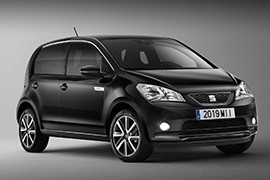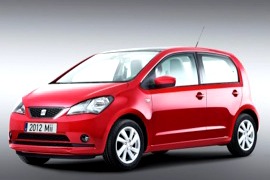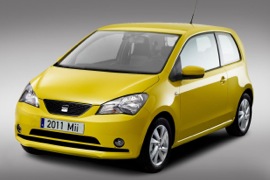SEAT Mii Models/Series Timeline, Specifications & Photos
First production year: 2011
Engines: , Gasoline, Natural gas
Body style: Hatchback
The Spanish brand Seat introduced the second iteration of the Mii nameplate in 2019 exclusively as an electric model but with just minor aesthetic changes.
The trio of Volkswagen up!, Skoda Citigo, and Seat Mii was built to attract young customers who needed a vehicle for cities, and it did that in 2012. But over time, customers started looking for EVs more than those that used internal combustion engines. So, the German automaker decided to revive all three models and re-launch them in 2019 but this time only with electron-powered motors. As a result, the Mii continued its journey without too many changes to its look.
It took a keen eye for detail to notice the upgrades made on the smallest SEAT on the market. These were noticed on the front bumper, which got redesigned and sported new, larger fog lamps. They flanked a broader lower grille, even though the car didn't need that much cooling area since it was electric. The automaker added a sticker on the sides that said "Mii electric." Still, the standard package was rich, with standard 16" light-alloy wheels. As a no-cost option, the Spanish brand offered a contrasting roof color.
The Mii kept the same spacious cabin as the 2012 model, with slim bucket seats at the front and a bench seat suitable for two adult passengers in the back. On the dashboard, the carmaker didn't have the option to install a fancy infotainment system. Still, it offered a phone cradle where customers could fix their smartphone and use it for navigation, music, or phone calls via Bluetooth connectivity.
But the most significant upgrade was under the car's skin, where SEAT installed a 36.8 kWh battery instead of the 18.6 kWh one that was previously used.
The Spanish cousin of the Volkswagen up! and Skoda CitiGo joined the small-sized vehicles offered by Volkswagen Group in 2011.
There was a high demand for very small city vehicles with three and five doors, for those who needed a car mostly to take the kids to schools and continue their way to their work. Basically, most of the car was the same as the other two from the group. It had a different hood, headlights, and slightly different rear tailgate and taillights. But all three of them were produced in the same Slovakian factory from Bratislava.
SEAT kept the same headlights' shape from the rest of the range, with an angular inbound side and rounded top exterior. Its trapezoidal grille with a honeycomb pattern tried to make the buyers believe that it was a sportier vehicle. Well, it wasn't. In the rear, the three triangular looks of its taillights were different than those installed on the CitiGo and up!.
Inside, the Mii featured exposed metallic parts on the interior door panels. Its dashboard was clean, designed in a minimalist design concept. The instrument cluster was fitted with three dials: a large speedometer, a fuel level, and the coolant temperature. Its tachometer was removed due to a lack of space. In the rear, the access was easy thanks to the wide opening of the doors. The rear windows were on hinges on the front side and could have been popping out. There was enough room for two adults and enough trunk space to carry a few pizza boxes.
It came with a small, 1.0-liter engine in three power options, including a factory-made NG version designed for fleets under the hood. It was available with a manual or automatic gearbox.
SEAT offered its smallest vehicle, the Mii, with three or five doors. It was the Spanish sibling of the Skoda CitiGo and the Volkswagen up!
There was a high demand for very small city vehicles with three doors, especially from the food delivery companies and sales representatives. Private customers asked for them if they didn't have to drop the kids to school. Basically, most of the car was the same as the other two from the group. It had a different hood, headlights, and slightly different rear tailgate and taillights. But all three of them were produced in the same Slovakian factory from Bratislava.
SEAT kept the same headlights' shape from the rest of the range, with an angular inbound side and rounded top exterior. Its trapezoidal grille with a honeycomb pattern tried to make the buyers believe that it was a sportier vehicle. Well, it wasn't. In the rear, the three triangular looks of its taillights were different than those installed on the CitiGo and up!.
Inside, the Mii featured exposed metallic parts on the interior door panels. Its dashboard was clean, designed in a minimalist design concept. The instrument cluster was fitted with three dials: a large speedometer, a fuel level, and the coolant temperature. Its tachometer was removed due to a lack of space. In the rear, the access was easier for the front passengers due to the wider doors than those on the five-door version but limited for the rear ones.
It came with a small, 1.0-liter engine in three power options, including a factory-made NG version designed for fleets under the hood. It was available with a manual or automatic gearbox.


